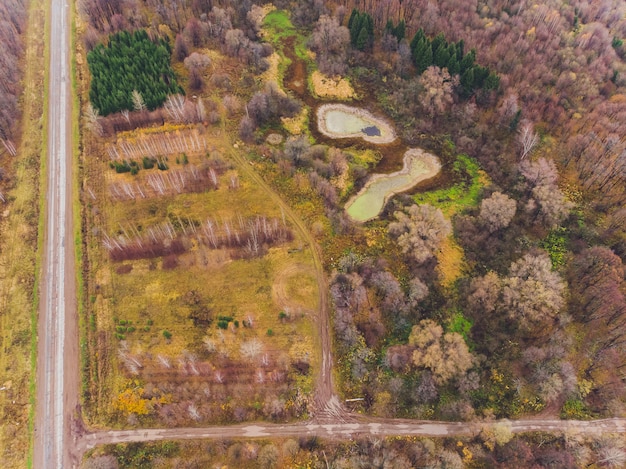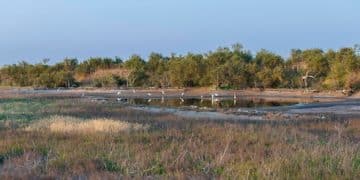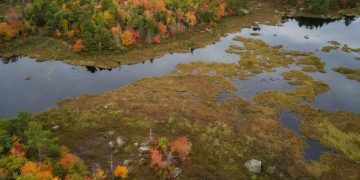Habitat Fragmentation: Long-Term Effects on US Wildlife

Habitat fragmentation in the US leads to decreased genetic diversity, increased extinction rates, altered species interactions, and reduced ecosystem resilience, posing significant long-term threats to wildlife populations.
Habitat fragmentation, the process where large, continuous habitats are divided into smaller, isolated patches, is a growing concern in the United States. The long-term effects of habitat fragmentation on wildlife populations in the US are far-reaching, impacting everything from genetic diversity to species survival. Understanding these effects is crucial for effective wildlife conservation strategies.
Understanding Habitat Fragmentation
Habitat fragmentation occurs when a continuous habitat is broken into smaller, isolated pieces. This can be caused by various human activities, such as urbanization, agriculture, road construction, and logging. The consequences of this fragmentation are complex and affect wildlife in numerous ways.
The process often begins with habitat loss, where the total area of suitable habitat decreases. This is then followed by habitat division, where the remaining habitat is broken into smaller patches. These patches are often surrounded by a matrix of altered or unsuitable habitat, further isolating wildlife populations.
Causes of Habitat Fragmentation
- Urbanization: The expansion of cities and towns leads to the conversion of natural habitats into built environments.
- Agriculture: Clearing forests and grasslands for agricultural purposes results in fragmented landscapes.
- Road Construction: Roads and highways act as barriers, dividing habitats and hindering wildlife movement.
- Logging: Deforestation for timber production fragments forests and disrupts ecosystems.
Habitat fragmentation is not just about the physical division of land; it also leads to changes in environmental conditions within the remaining habitat patches. Edge effects, for example, can alter temperature, humidity, and light levels, impacting the species that live there.

In conclusion, understanding the causes and processes of habitat fragmentation is essential for assessing its long-term effects on wildlife populations. By recognizing the various factors that contribute to fragmentation, we can develop more effective strategies for mitigating its impacts and conserving biodiversity.
Genetic Diversity and Habitat Fragmentation
One of the most significant long-term effects of habitat fragmentation is the reduction of genetic diversity within wildlife populations. When habitats are fragmented, populations become isolated, preventing gene flow and leading to inbreeding and genetic drift.
Genetic diversity is crucial for the long-term survival of any species. It allows populations to adapt to changing environmental conditions and resist diseases. When genetic diversity is reduced, populations become more vulnerable to extinction.
Consequences of Reduced Genetic Diversity
- Inbreeding Depression: Increased inbreeding leads to the expression of harmful recessive genes, reducing fitness and survival rates.
- Lowered Disease Resistance: Genetically similar populations are more susceptible to disease outbreaks.
- Reduced Adaptive Potential: Loss of genetic variation limits the ability of populations to adapt to new environmental challenges.
Studies have shown that fragmented populations often exhibit lower levels of genetic diversity compared to those in continuous habitats. This is particularly true for species with limited dispersal abilities or those that require large home ranges.
For example, consider a population of deer living in a forest that is fragmented by roads and development. The deer in each fragment may be unable to move between patches, leading to reduced gene flow and increased inbreeding within each subpopulation.
In conclusion, the reduction of genetic diversity is a critical long-term effect of habitat fragmentation. Conservation efforts must focus on maintaining and restoring connectivity between habitat patches to promote gene flow and preserve the genetic health of wildlife populations.
Population Size and Extinction Risk
Habitat fragmentation often leads to smaller population sizes, which in turn increases the risk of extinction for many wildlife species. Smaller populations are more susceptible to environmental fluctuations, genetic drift, and demographic stochasticity.
When a habitat is fragmented, the carrying capacity of each patch is reduced, meaning it can support fewer individuals. This can lead to a decline in population size and an increased risk of local extinction.
Factors Increasing Extinction Risk
- Demographic Stochasticity: Random variations in birth and death rates can have a significant impact on small populations.
- Environmental Fluctuations: Small populations are more vulnerable to extreme weather events, diseases, and other environmental changes.
- Allee Effect: Reduced population density can lead to decreased reproductive success and survival rates.
The Allee effect, for example, describes a situation where the per capita growth rate of a population decreases as the population size becomes smaller. This can occur due to factors such as reduced mate-finding success or decreased cooperative behaviors.

Habitat fragmentation also increases the isolation of populations, making it difficult for individuals to disperse and recolonize areas where local extinctions have occurred. This can lead to a gradual decline in the overall population size and an increased risk of regional extinction.
In conclusion, the reduction of population size and the increased risk of extinction are significant long-term effects of habitat fragmentation. Conservation strategies must focus on maintaining and restoring habitat connectivity to support larger, more resilient populations.
Changes in Species Interactions
Habitat fragmentation not only affects individual species but also alters the interactions between species within an ecosystem. These changes can have cascading effects, impacting the structure and function of the entire community.
Fragmentation can lead to the loss of keystone species, which are species that play a critical role in maintaining the structure and function of an ecosystem. The loss of a keystone species can trigger a series of extinctions and alter the balance of the entire community.
Examples of Altered Species Interactions
- Predator-Prey Dynamics: Fragmentation can disrupt predator-prey relationships, leading to increased predation rates or the decline of prey populations.
- Competition: Fragmentation can increase competition between species for limited resources, leading to the exclusion of some species.
- Mutualism: Fragmentation can disrupt mutualistic relationships, such as pollination and seed dispersal, which are essential for plant reproduction.
For example, fragmentation can lead to an increase in edge habitat, which can favor generalist predators such as raccoons and foxes. These predators may then prey more heavily on the nests of songbirds, leading to a decline in songbird populations.
Habitat fragmentation can also disrupt pollination and seed dispersal, which are essential for plant reproduction. Many plants rely on animals to transfer pollen or seeds between individuals, and fragmentation can reduce the movement of these animals, leading to a decline in plant populations.
In conclusion, the changes in species interactions caused by habitat fragmentation can have significant long-term effects on ecosystem structure and function. Conservation efforts must consider these complex interactions and focus on maintaining and restoring habitat connectivity to support healthy and diverse communities.
Increased Edge Effects
Edge effects refer to the changes in environmental conditions that occur along the boundary of a habitat patch. These changes can include alterations in temperature, humidity, light levels, wind speed, and vegetation structure, impacting the species that live there.
As habitats become more fragmented, the amount of edge habitat increases relative to the amount of interior habitat. This can have a significant impact on wildlife populations, particularly those that require large areas of undisturbed interior habitat.
Impacts of Increased Edge Effects
- Increased Predation: Edge habitats often have higher densities of predators, which can increase predation rates on prey species.
- Invasive Species: Edge habitats are more susceptible to invasion by non-native species, which can outcompete native species and alter ecosystem dynamics.
- Altered Microclimate: Changes in temperature, humidity, and light levels can affect the survival and reproduction of sensitive species.
For example, the brown-headed cowbird is a parasitic bird that lays its eggs in the nests of other birds. Cowbirds are more common in edge habitats, and their parasitism can have a significant impact on the reproductive success of songbirds in fragmented landscapes.
Edge effects can also alter plant communities, favoring species that are tolerant of disturbed conditions. This can lead to a decline in native plant species and a shift in the overall vegetation structure of the habitat.
In conclusion, the increased edge effects caused by habitat fragmentation can have significant long-term effects on wildlife populations and ecosystem dynamics. Conservation strategies must focus on minimizing edge effects and maintaining large areas of intact interior habitat.
Ecosystem Resilience and Fragmentation
Ecosystem resilience refers to the ability of an ecosystem to withstand disturbances and recover to its original state. Habitat fragmentation can reduce ecosystem resilience, making ecosystems more vulnerable to environmental changes and disturbances.
Fragmented ecosystems often have lower biodiversity, reduced genetic diversity, and altered species interactions, all of which can reduce their ability to cope with disturbances such as climate change, disease outbreaks, and invasive species.
Factors Affecting Ecosystem Resilience
- Biodiversity: Higher biodiversity provides a greater range of species to fill different ecological niches, making the ecosystem more resilient to disturbances.
- Connectivity: Habitat connectivity allows species to move and adapt to changing environmental conditions, enhancing ecosystem resilience.
- Functional Redundancy: Functional redundancy refers to the presence of multiple species that perform similar ecological roles. This provides a buffer against the loss of any single species.
For example, if a fragmented forest is subjected to a severe drought, the reduced genetic diversity and altered species interactions may make it more difficult for the forest to recover. This can lead to a long-term decline in forest health and productivity.
Habitat fragmentation can also reduce the ability of ecosystems to provide essential ecosystem services, such as clean water, pollination, and carbon sequestration. This can have significant economic and social consequences.
In conclusion, the reduction of ecosystem resilience is a critical long-term effect of habitat fragmentation. Conservation efforts must focus on maintaining and restoring habitat connectivity, promoting biodiversity, and enhancing the ability of ecosystems to withstand disturbances.
Conservation Strategies for Mitigating Fragmentation
Addressing the long-term effects of habitat fragmentation requires a multi-faceted approach that includes habitat preservation, restoration, and connectivity enhancement. These strategies aim to maintain and restore biodiversity, promote genetic diversity, and enhance ecosystem resilience.
Habitat preservation involves protecting existing areas of intact habitat from further fragmentation. This can be achieved through land acquisition, conservation easements, and zoning regulations.
Effective Conservation Approaches
- Habitat Corridors: Establishing corridors or stepping stones of habitat to connect fragmented patches and facilitate wildlife movement.
- Restoration Ecology: Restoring degraded habitats to improve their quality and increase their size.
- Sustainable Land Use Planning: Implementing land use policies that minimize habitat fragmentation and promote sustainable development.
Habitat restoration involves restoring degraded habitats to improve their quality and increase their size. This can include reforestation, wetland restoration, and removal of invasive species.
Connectivity enhancement involves creating corridors or stepping stones of habitat to connect fragmented patches and facilitate wildlife movement. This can be achieved through the construction of wildlife crossings over roads and highways, the creation of riparian buffers along streams and rivers, and the establishment of greenways through urban areas.
In conclusion, mitigating the long-term effects of habitat fragmentation requires a comprehensive conservation strategy that includes habitat preservation, restoration, and connectivity enhancement. By implementing these strategies, we can help to protect wildlife populations, maintain biodiversity, and enhance the resilience of ecosystems in the face of ongoing habitat fragmentation.
| Key Point | Brief Description |
|---|---|
| 🧬 Reduced Genetic Diversity | Isolation prevents gene flow, leading to inbreeding and decreased adaptability. |
| ⚠️ Extinction Risk | Small populations are more vulnerable to stochastic events and environmental changes. |
| 🌿 Altered Interactions | Changes in predator-prey dynamics and disrupted mutualistic relationships degrade ecosystems. |
| 🚧 Increased Edge Effects | More edge habitat favors invasive species and generalist predators. |
Frequently Asked Questions
▼
Habitat fragmentation is the process by which large, continuous habitats are divided into smaller, isolated patches, often due to human activities like urbanization and agriculture.
▼
Fragmentation reduces gene flow between populations, leading to inbreeding and a loss of genetic diversity, which makes species more vulnerable to diseases.
▼
Edge effects are changes in environmental conditions along habitat boundaries, such as increased predation and invasion by non-native species, altering ecosystem dynamics.
▼
Conservation strategies include preserving intact habitats, restoring degraded areas, and creating habitat corridors to connect fragments and facilitate wildlife movement.
▼
Ecosystem resilience, the ability to recover from disturbances, is crucial because fragmented ecosystems are more vulnerable to environmental changes and need stronger recovery capabilities.
Conclusion
In conclusion, the long-term effects of habitat fragmentation on wildlife populations in the US are significant and far-reaching. Addressing these effects requires a comprehensive conservation strategy that includes habitat preservation, restoration, and connectivity enhancement to protect biodiversity and enhance ecosystem resilience.





